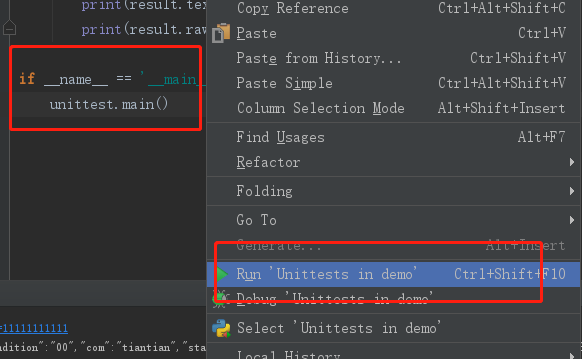一:unittest跑起来
unittest使用,具体使用方式可以查看unittest官网,以下简单做个介绍,在工作中使用最多的
#
第一步:
创建unittest类,且一定要继承unittest.TestCase
class MytestDemo(unittest.TestCase):
第二步:
创建你要运行的方法,且一定是用test开头,unittest是检测test开头就会认为有运行方法,如果不用test开头就不用
def test_show():
print(运行成功)
第三步:
运行,使用main入口
if __name__ == '__main__':
unittest.main()
好了至此,你就已经是使用unittest框架了
但是这样其实在工作中不能满足我们,我们在执行测试方法前都会做一些前置条件,依赖于unittest中的几个方法
二、增加初始化的方法,
在类中,添加,setUp (前置方法,每次运行方法时就会运行),tearDown(运行完后的后置处理,每个方法运行时就会运行)setUpClass(第一次运行类时,开始运行)
#coding=utf-8
import unittest
import requests
class MytestDemo(unittest.TestCase):
'''
http: // www.kuaidi100.com / query?type = 快递公司代号 & postid = 快递单号
测试用例
ps:快递公司编码:申通 = "shentong"
EMS = "ems"
顺丰 = "shunfeng"
圆通 = "yuantong"
中通 = "zhongtong"
韵达 = "yunda"
天天 = "tiantian"
汇通 = "huitongkuaidi"
全峰 = "quanfengkuaidi"
德邦 = "debangwuliu"
宅急送 = "zhaijisong"
number=1
'''
@classmethod
def setUpClass(cls):
print("第一次运行类时调用")
def setUp(self):
self.url = "http://www.kuaidi100.com/query"
self.headers1 = { 'Connection': 'keep-alive'}
def tearDown(self):
print("后面收尾")
def test_yuantong(self):
url=self.url+"?type=yuantong&postid=11111111111"
result=requests.get(url=url,headers=self.headers1)
print(result.url)
print(result.text)
def test_tiantian(self):
data = "type=tiantian&postid=11111111111"
result = requests.get(url=self.url, params=data,headers=self.headers1 )
print("************")
print(result.url)
print(result.text)
if __name__ == '__main__':
unittest.main()
我使用了两个方法,一个圆通,一个天天,self.url就是获取在setUp中的url,显示内容:

三、运行
3.1 单个类运行
在类的方法旁边,使用运行,运行单个方法

3.2: 整体运行
在main中运行,

在运行方式中,unittest.main(),还有几种方式表示
使用unittest.TestSuite()集合方式运行,这种方式可以在单个类中运行,也可以在运行多个文件
if __name__ == '__main__': #unittest.main() suite = unittest.TestSuite() suite1 = unittest.TestLoader().loadTestsFromTestCase(MytestDemo) # 增加文件 suite.addTest(suite1) unittest.TextTestRunner().run(suite1)

针对TestLoader运行方式有几种,类名,文件名,运行方法名,后续在写一篇